How Do I Get My Name Off A Business

Imagine the pride, the exhilaration of etching your name onto a business venture, a testament to your hard work and dreams. Now, picture the reverse: the subtle, yet persistent, unease of wanting that name removed, a chapter closed, a new direction beckoning. It's a situation more common than you might think, a delicate dance between legacy and fresh starts.
Navigating the process of removing your name from a business, whether a partnership, LLC, or corporation, requires careful planning and execution. This isn't just about paperwork; it's about severing legal ties, protecting your future, and maintaining professional integrity.
Understanding the Legal Landscape
The initial step is understanding the legal structure of the business. Are you a partner in a general partnership, a member of a Limited Liability Company (LLC), or a shareholder in a corporation? The answer dictates the specific procedures you must follow.
For general partnerships, dissolution or amendment of the partnership agreement is usually required. LLCs necessitate reviewing the operating agreement, which outlines procedures for member departures and name changes. Corporations involve more complex processes, often including shareholder votes and amendments to the articles of incorporation, according to legal experts at Nolo.
Partnership Dynamics
If you're in a partnership, the partnership agreement is your guiding star. It should detail how a partner can withdraw and what happens to the business name upon withdrawal.
Often, the remaining partners must agree to the name change. If the agreement is silent, state partnership laws will govern, typically requiring unanimous consent for significant changes like removing a partner's name from the business, explains resources from the Small Business Administration (SBA).
LLC Considerations
LLCs offer more flexibility but still require adherence to the operating agreement. This document usually outlines the procedures for a member's departure and the potential impact on the business name.
Removing your name might require a formal amendment to the articles of organization, filed with the Secretary of State. It's crucial to ensure all members agree and that the amendment accurately reflects the change in ownership and branding, as suggested by the U.S. Chamber of Commerce.
Corporate Structures
Removing your name from a corporation, especially if it's prominently featured in the corporate branding, can be complex. It often necessitates a shareholder vote to approve the name change.
Furthermore, amending the articles of incorporation and notifying all relevant stakeholders – customers, vendors, and regulatory bodies – is essential. Legal counsel is highly recommended to navigate the intricacies of corporate law and ensure compliance, the American Bar Association advises.
The Practical Steps
Beyond the legalities, several practical steps are crucial. Firstly, communicate your intentions clearly and professionally to your business partners or fellow members. Transparency and open dialogue can prevent misunderstandings and foster a smoother transition.
Secondly, draft a formal agreement outlining the terms of your departure and the name change. This document should specify the effective date of the change and address any financial implications, such as your share of profits or liabilities, the Internal Revenue Service (IRS) highlights.
Thirdly, update all relevant business documents and registrations. This includes your website, marketing materials, bank accounts, and any licenses or permits. Failure to do so can lead to legal complications and confusion among customers.
Protecting Your Reputation
Removing your name is also about protecting your reputation. Ensure that the remaining business continues to operate ethically and responsibly, even after your departure.
Consider including a clause in your departure agreement that allows you to disassociate yourself from any future actions that may damage your professional image. Regularly monitor the business's online presence and address any concerns promptly to safeguard your brand.
Finally, remember that this is a significant step. Seek legal and financial advice to understand the potential implications and ensure a clean break. Document everything thoroughly and maintain open communication with all parties involved.
Leaving a business, even when amicable, can be emotionally charged. Approaching the name removal process with careful planning, open communication, and a focus on protecting your future will ensure a smooth and successful transition, allowing you to confidently embark on your next chapter. It's about more than just erasing a name; it's about securing your legacy and embracing new possibilities.



:max_bytes(150000):strip_icc()/How-to-remove-your-name-from-a-cosigned-loan-960968_Final3-5880ee67f82b43e7bd81edf9a3147be2.png)














